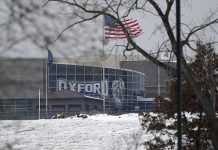It’s morning rush hour in Ann Arbor — the downtown shops and restaurants begin to glow as the sun rises, pedestrians late to work rush out in front of street traffic, and the road narrows to one lane during construction season.
But in this particular rush hour, the “pedestrians” are robots and the vehicles don’t have drivers shaking their heads in frustration.
Welcome to Mcity — a 32-acre test facility for connected and automated vehicles that’s a replica of an urban environment — complete with bike lanes, roundabouts, trees, and tunnels.
“We created Mcity largely as a dense, complex urban environment that we could accelerate the testing process by presenting complex situations for the senses and the software — that’s the key to it,” says Peter Sweatman, director of the University of Michigan Mobility Transformation Center. “If the situation is a pedestrian walking out suddenly from between two parked cars, then we’re able to reproduce that in exactly the same way as many times as the developers need in order to get their systems right.”
More than six months after it opened, the testing grounds are nearly fully booked, with the more than 50 companies that are financial contributors choosing days to rent out the facility for research purposes.
Sweatman says Mcity researchers are not only working on connected and automated vehicles and all the issues surrounding their use, but they’re also developing solutions for issues that extend to metro Detroit’s lack of a world-class public transportation system.
There are plans to bring an urban shuttle-type driverless vehicle that operates like car-sharing service Uber to Mcity. Customers would be able to request a driverless shuttle from their cellphones. The service has been undergoing testing in some European countries.
“You can call up a ride and the machine will arrive and take you where you want to go and then go away,” Sweatman says. “That’s what we’re aiming for (deploying) within an eight-year time frame in the city of Ann Arbor.”
He feels Mcity, and planned deployments into the city of Ann Arbor and beyond, will put Michigan on the map in terms of becoming a hub for autonomous vehicle development.
“We see it as a huge attractor,” Sweatman says. “We think it’s really important that we have a very welcoming environment here in Michigan when it comes to these kind of technologies.”

The technology developed at Mcity has the potential to change not only the lives of southeast Michigan residents, but also the lives of people across the world.
Sweatman says while deployments in Ann Arbor are the next step, Mcity will work with other testing grounds and cities across the country to set up larger and larger deployments.
“That’s when we’ll see a transformation in the way the whole system performs in the way that it’s going to enhance peoples’ lives — people from all walks of life,” Sweatman says.
One local company who recognized the value early on in Mcity was Ford. The Dearborn-based automaker was the first to test an autonomous vehicle at the testing grounds and is a member of the “leadership circle.” The group of 16 companies meets regularly to develop key research questions that all the companies want to work on, such as human response — what happens when the human has to go from a passive mode to an active mode in a vehicle? — cyber security, and legal and liability issues.
Ford is testing its Fusion Hybrid Autonomous Research Vehicle at Mcity. It merges available driver-assist technologies like front-facing cameras with sensors to generate a real-time 3-D map of the grounds, “interacting in different, difficult scenarios so that we can develop the sensors and develop the algorithms for automated driving,” says Greg Stevens, global manager of automated driving for Ford Research and Innovation and Ford’s representative on the multi-company leadership circle.
He says Mcity is unlike most testing grounds — even Ford’s own proving grounds in Dearborn and Arizona.
“(Ford’s proving grounds) have high-speed tracks, handling courses, and vehicle dynamic areas that look like just massive parking lots, but they’re all very flat,” Stevens says. “What we really needed was a place that looked more like an urban environment so that we could have same sort of controlled proving ground atmosphere but in a situation where we could add in some of the sort of chaotic and difficult factors that occur in urban driving.”
Both Sweatman and Stevens see Mcity’s value not only in its ability to offer a wide range of driving conditions so autonomous vehicles will be prepared to one day drive on real roadways, but also in its ability to connect a broad range of companies together to talk about issues with liability, security, and consumer value, among others.
“A lot of people kind of jump to the idea that with automation it’s all about technology (but) it’s almost that technology is the least of the issue,” Sweatman says. “We see already that consumers are extremely excited about automation, but we don’t know exactly what they value. At the end of the day we need something that everybody is going to love and want to use.”
|
|
|










